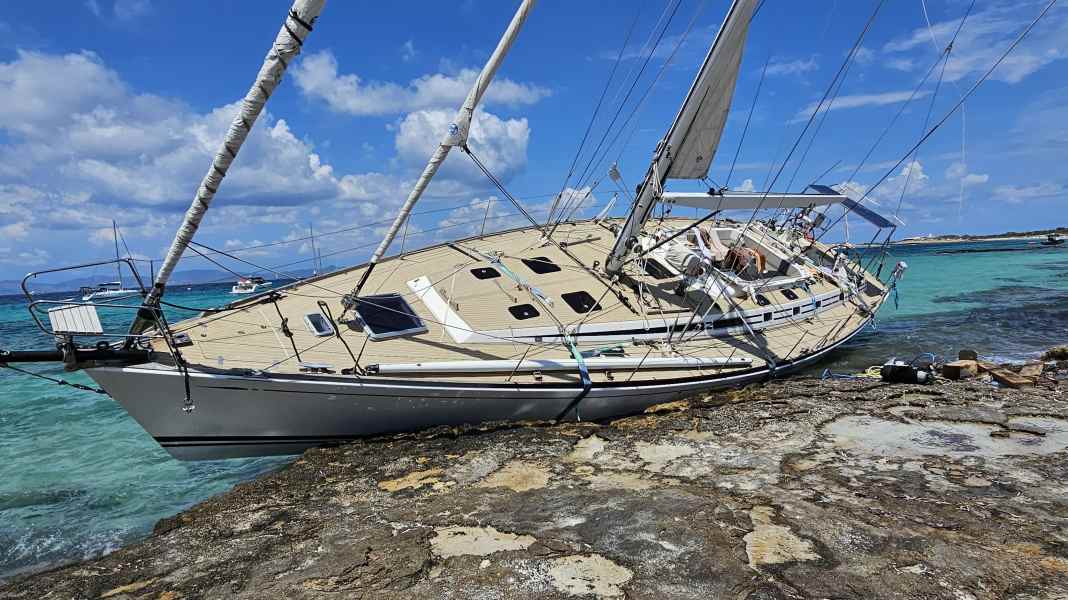
A team from Marine Claims Service (MCS) Spain and a second team from Hamburg-based insurer Pantaenius have been on site for a few days now, rescuing the stranded Wally "Wally Love" from the rocks and a Swan 60, among other things. The man for jobs like this is Ole Pietschke, who has of course also spoken to various affected owners on site. Many readers will remember him from the videos from last autumn, when he was heavily involved in the salvage work on the German Baltic Sea after the autumn storm.
One owner reported 75 knots of wind. After only 30 minutes it was all over
"The wind picked up very quickly, from 25 knots to around 50 knots, one owner reports that he measured 75 knots on his anemometer. And after 30 minutes it was all over. The problem is that if you miss the right time to go out, you won't be able to cope with such winds. One owner of a larger Jeanneau, which has a 120 hp engine, was still travelling 0.3 knots at full throttle against the wind." Those with weaker engines sometimes didn't stand a chance.
At this point, you will find external content that complements the article. You can display and hide it with a click.
One problem, of course, is that many were still at anchor when they were surprised by the weather. "A few crews were clever enough to sacrifice their anchor gear and let the end of the chain run out. It happened so quickly that they made it out to sea and weathered the worst of it there."
Many yachts had also failed to minimise the area exposed to the wind: Mainsails that were not properly secured, furling jibs that had unrolled, sealed the fate of many a yacht in the blink of an eye, which then ran aground with the anchor still deployed.
Some of those that did not manage to escape at the last minute ended up on the rocks of the anchorage bay north of Savina on Formentera. This included the two ships that the MCS team was able to recover relatively quickly. The Wally had only taken on a little water and had no holes in its side, which was lying on the beach. The Swan, on the other hand, had the latter in one side and had taken on a lot of water.
How are the yachts salvaged?
But the procedure is actually the same, says Pietschke: "First of all, we have to lay the boat on its other side so that the keel doesn't point in the direction of the tow and get stuck on the bottom." To do this, the side of the yacht that is accessible from the top is padded with air bags and special recovery mattresses so that it is not damaged further when the hull is turned. The holes are then provisionally sealed and all the water pumped out. The towing cables and straps are then fastened around particularly stable points on the yacht, i.e. the mast base, bulkheads, etc. Once the yacht has been turned round, it can be pulled into deeper water lying on the cushions. This was achieved with both yachts, which were then craned ashore on Ibiza.
Opinions are quite clear when it comes to the question of how this disaster could have happened. Locals and some forecasts warned three or four days in advance of such a possible development for a cold air intrusion from the higher air layers (called Gota Fria or Dana). However, some crews relied solely on weather apps, such as Windy, and the warnings only came two days in advance. "The local weather services are often more accurate when it comes to such regionally specific weather phenomena, so skippers would do well to include them in the process," says Pietschke.
The Pantaenius team filmed the recovery work on site, and a detailed report will be published in the next few days. Video report from Pantaenius.
Many crews have to ask themselves why, with such a weather forecast, they anchor in a completely unprotected bay that is completely open to the west and obviously don't keep an eye on the weather, for example with the usual weather radar displays, which would probably have depicted the approaching storm, including precipitation and thunderstorm cells, as locals confirm. In any case, the locals say that it was clear that a storm was coming, but even they were surprised by the force and strength of the wind.

